Article first published in August 2015, updated June 2019
Your new product or service has finally arrived, and you know it’s going to be a big win for your business.
You’re excited to launch it, so you put it on your website, send your email campaign, and wait for the sales to roll in.
But, for some reason, they don’t come. Despite your best efforts, people aren’t clicking on your email and purchasing the new product from your site.
Here’s where using some social proof can help.
In this post, we’ll discuss what social proof is and give you examples of five different types of social proof you can use to increase your email click-through rate and drive sales.
What is social proof?
Social proof is a psychological phenomenon where people conform to the actions of others simply because they believe that, if other people are doing it, it must be the right thing to do.
In a study published in the Wall Street Journal, researchers tested whether social proof was a more powerful driver of human behavior than saving money or saving the environment. They used four different messages to try and convince people to use fans instead of air conditioning:
- Message 1 – Informed the customer that they could be saving $54/month on their utility bill.
- Message 2 – Told customers that they could prevent the release of 262 pounds of greenhouse gasses every month.
- Message 3 – Informed customers that saving energy was a socially responsible thing to do.
- Message 4 – Let customers know that 77% of their neighbors were already actively using fans to save energy.
Guess what message was the most effective at getting people to use less energy? Message 4 – the one that invoked the use of social proof.
That’s how influential social proof is on human behavior. Our desire to fit in is actually more persuasive than saving money or protecting the environment.
What is social proof in marketing?
Social proof in marketing works in the same way. Potential customers see the examples of others before them and they assume that, if they follow in those individual’s footsteps, then they, too, will reap the benefits.
So, for example, if someone is selling a weight loss aid, they may share examples of current customers and their success while using the product.
Why do social proofs work?
Social proof pulls the potential customer’s emotions in an attempt to get them to move through the sales cycle.
Nearly 63% of consumers state that they’re more likely to purchase from a site if it has not only product reviews, but also product ratings. This is why social proofs work, because it gives users a more “in your face” example of who’s using the products, what they think of them, and if they work or not.
 Source: Search Engine Journal
Source: Search Engine Journal
5 types of social proof to use in your email marketing campaigns
So how can you use insight into how human beings are motivated to act to improve your email click-through rates? By adding elements of social proof to your email marketing campaigns.
Here are five different types of social proof you can use:
1. Customer testimonials
If you’ve got a great product that your customers love using, including testimonials in your email marketing campaigns can be a great way of letting potential customers see that passion.
Freshbooks does a great job of this in their email campaign announcing the launch of their new ZenPayroll integration feature.
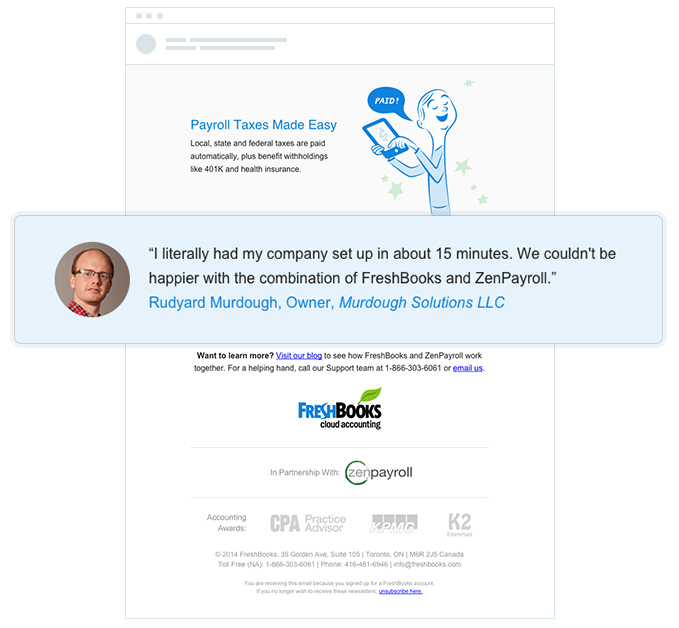
The testimonial from a happy customer who already uses the solution goes a long way in persuading others to try it out as well. By seeing that other people, like Rudyard here, are successful using the product reassures others that they will be as well.
2. Customer or usage numbers
While FOMO (Fear of Missing Out) is commonly joked about, it’s actually a recognized psychological phenomenon where people are driven to take action by the fear that they may be missing out on opportunities others are receiving.
Anybody who’s ever felt FOMO, even in social situations, can attest to the fact that it’s a powerful driver of human behavior, so it’s worth leveraging in your email campaigns to help increase your click-through rates.
InVision does this effectively by showcasing the fact that 300,000 other designers are using their tool to improve their design process.
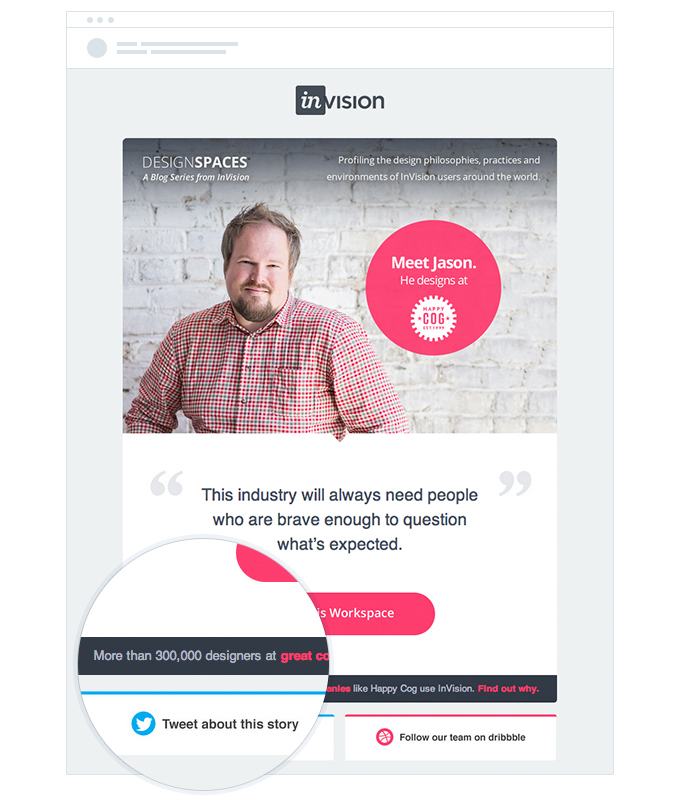
By showcasing customer numbers like this, InVision triggers people’s fear that other designers may be getting opportunities or benefits they’re not receiving, and are compelling people to click-through from the email and try out their product.
3. Awards
Another way to use social proof is to showcase awards your company has received.
Industry awards—particularly well-known ones—typically hold a lot of credibility among members of a particular industry. So, when you or your product are honored with one of these awards, that credibility and respect is passed over to you, due to a psychological phenomenon known as the Halo Effect.
Werkpress used this in their campaign announcing the launch of their new site.
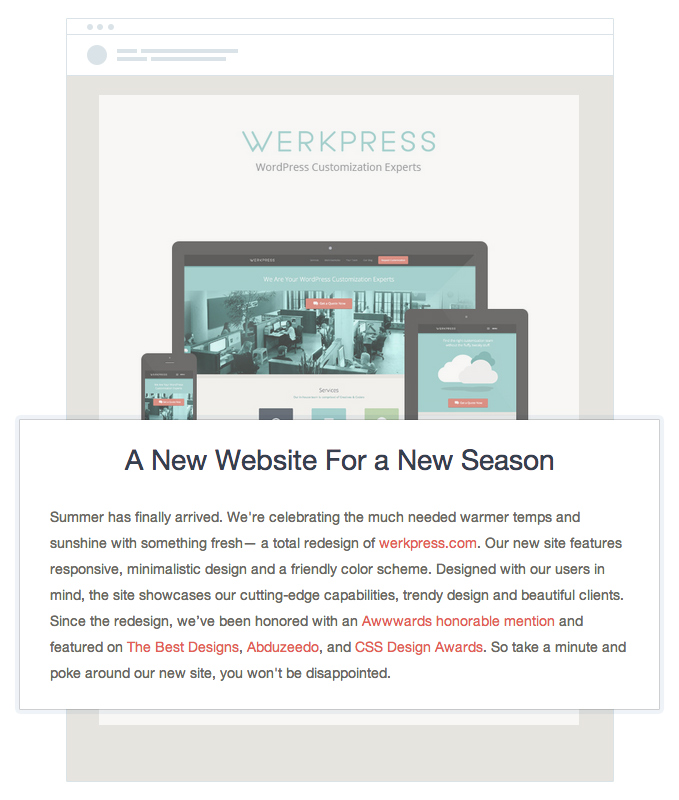
After informing customers of the redesign, they go on to say that the site has been honored with an Awwwards honorable mention.
This is a well-known industry award (in the design industry), so the fact that their new site received the award gives it a new level of credibility that encourages people to click through the email campaign and check it out.
4. Product reviews
Adding reviews from real customers who’ve used your product is a great way to increase your email click-through rate.
In fact, when e-commerce store Figleaves.com tested including product reviews in their marketing, they saw a 37.5% increase in conversions.
Campaign Monitor customer Franklin Rd does a great job of this in their email campaigns.
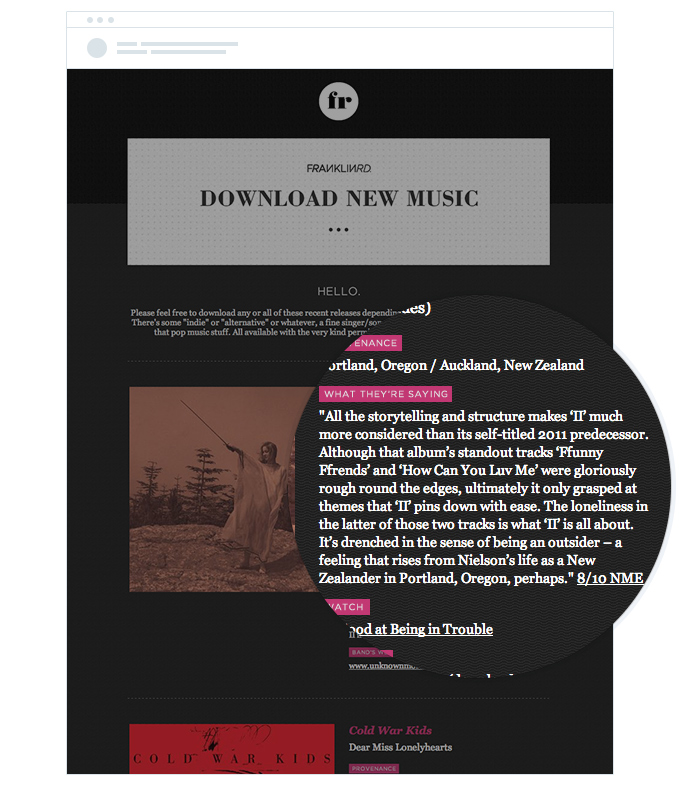
By showing customer reviews in their campaigns, Franklin Rd reassures potential listeners that clicking through and checking out the albums is worth their time. This element of social proof, combined with other information and visuals like the album cover, increases the chances that people will click through and drives conversions.
5. Press mentions
If you’re lucky enough to have had your product reviewed (or even mentioned) by popular news sites or industry publications, then including that in your email campaigns can be a great way to increase conversions.
In a similar way as industry awards, these publications hold a lot of credibility and authority with your potential customers, and showing that they’ve been talking about your business gives you instant credibility.
Campaign Monitor customer Oribe does an awesome job of leveraging media coverage in their email campaigns.
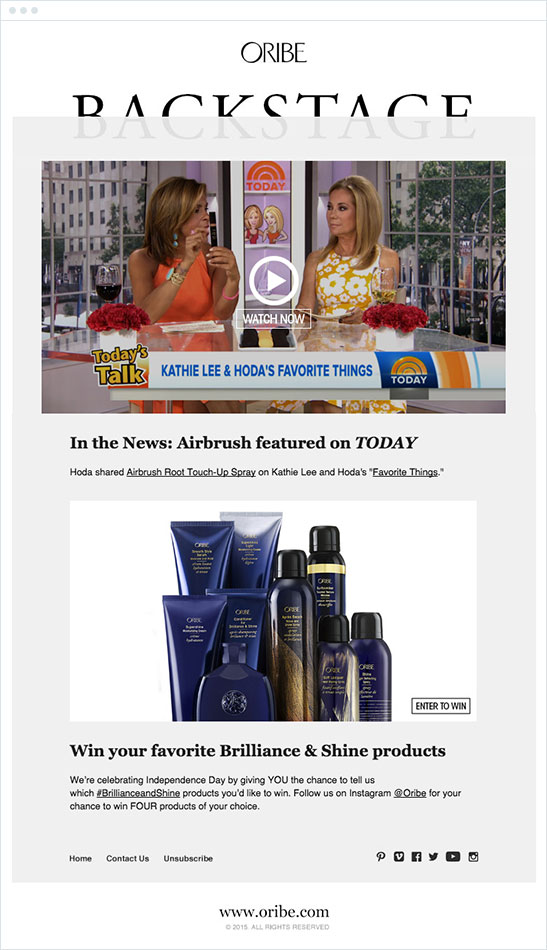
Oribe was fortunate to have their product featured on The Today Show, and, while that in itself is a huge win, it’s their use of that mention as social proof that’s really impressive.
By including it in their email campaigns, they’re showcasing to potential customers that their product is one of The Today Show’s “Favorite Things” and passing the credibility and likeability the show has onto their product.
Tips for using social proof effectively
Before you start implementing social proof in your email campaigns, let’s look at some best practices for doing so, as not all forms of social proof are created equal—and getting it wrong can actually hurt conversions.
Be careful of negative social proof.
Wording is everything when it comes to social proof, and it’s easier than you think to get wrong.
In a research study conducted at Petrified Forest National Park in Arizona, researchers tested several different signs to try and discourage people stealing wood from the forest.
One of the signs read:
Many past visitors have removed the petrified wood from the park, destroying the natural state of the Petrified Forest.
Even though the sign points out the damage that theft is doing to the forest when this sign was up, the amount of theft tripled.
Why? Because by telling people that many visitors before them had stolen wood from the park, they were showing people this action was a common activity being undertaken by others, effectively making the bad behavior more acceptable in people’s minds.
So, if you’re going to use social proof in your email marketing, the key is making sure you’re saying that the majority of people took the action you want them to take, not the action you don’t them to take.
Personalize your testimonials to increase credibility.
While testimonials remain a great way to increase conversions in your email campaigns, it’s unfortunate that some less credible marketers than yourself have used testimonials liberally.
As a result, people have become less trusting of them, knowing that it’s pretty easy to simply make them up or quote friends or colleagues saying great things about your product.
To overcome this, make sure you accompany your testimonials with details about the customer, such as their full name, position, company, and even a photo.
Freshbooks’ use of a testimonial in their email above is a perfect example of this.
Rather than just including a quote from “Rudyard M” they go all in, including his full name, position, company name, and even his image.
This reassures people it’s from a real person and adds a level of credibility to the testimonial that makes it more effective at driving conversion.
Avoid displaying small amounts of social proof.
While social proof is useful, you don’t want to start using it until you have something to show off.
InVision’s use of their customer number in their email campaigns works because it’s a large number, and triggers people’s fear that they may be missing out on opportunities or benefits that hundreds of thousands of other designers are receiving.
However, if they only had five customers, then showcasing that number would likely achieve the exact opposite effect. It would show potential customers that not many other designers are using this product and that it’s probably not worth their time exploring.
Real-world examples of social proof in action.
Social proof can come in several different forms, and, when it comes to adding it to your email campaigns, email marketers want to strike a balance between proof and content.
Remember, while selling a product is generally the end goal, you don’t want to overwhelm your readers either. That said, here are a few real-world examples of the perfect balance between social proof and content in email campaigns.
Coastal – reader’s choice/best in show
This example of social proof from Coastal sat well with us because they made it about the readers, not about their products. Are they promoting their sunglasses? Yes, but they’re using customer feedback to guide readers through the “best in show” top picks.
Source: Really Good Emails
Takeaway: Let the readers do the talking. This “best in show” example allows the brand to display their best sellers, but the consumers are supplying the content by giving their social proof as to why each product was chosen to be apart of the best in show lineup.
Body Boss – see how Katie lost over 60lbs
This example by Body Boss does an exceptional job at tugging at the reader’s emotions. We have a real-world person telling us her real-world story. It has all the makings of ideal social proof: emotion, results, and positive feedback for the product being presented.
They also leave CTAs that’ll take them where they need to go if they feel they can benefit from their product as this woman did.
Source: Milled
Takeaway: Let your consumers tell their story. Consumer stories are some of the most powerful forms of social proof out there. When you give a consumer the chance to be open and vulnerable, it’s going to impact your subscribers. It’ll tug at their emotions, and, if they’re looking for similar results from a product, it’s these real-world stories that’re going to convince them to make the final conversion.
Revolution Tea – the results are in
Revolution Tea was so grateful that they had such a wonderful response from consumers that they went ahead and sent out a little “thank you” promo to their readers. They also did an excellent job of adding in some additional social proof at the end of their email to help justify their 94% recommendation rating that they claim to have received from customers.
 Source: Really Good Emails
Source: Really Good Emails
Takeaway: If you’re presenting statistics to your readers, adding social proof into your email is an excellent way to back that data up. Just remember, don’t falsify information, because the truth always comes out. So using social proof to back up positive data is a great idea, but don’t present false information to readers in the process.
Wrap up
Social proof isn’t just a marketing tactic; it’s a fundamental driver of human behavior and genuinely influences how people decide to act.
By incorporating the tips in this post, you can leverage social proof to increase your email click-through rate and drive sales, and using Campaign Monitors drag-and-drop template builder will help you create stunning emails to help you share your social proof with your readers. Request your live demo today.







